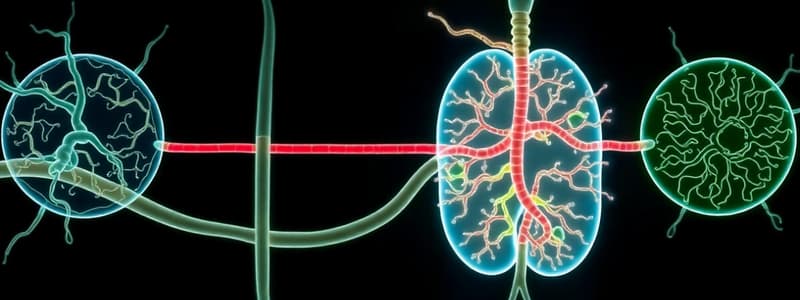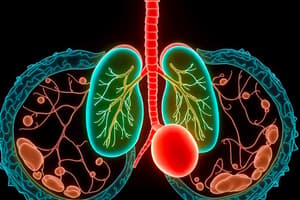Podcast
Questions and Answers
What is the primary function of cellular respiration?
What is the primary function of cellular respiration?
- To facilitate the absorption of nutrients
- To release potential energy from organic compounds (correct)
- To produce glucose for plant photosynthesis
- To synthesize lipids for cellular membranes
During which process is glucose oxidized to produce reducing power in NADH and FADH?
During which process is glucose oxidized to produce reducing power in NADH and FADH?
- Fermentation
- Krebs cycle (correct)
- Glycolysis (correct)
- Photolysis
Where does chemiosmosis occur in the mitochondrion?
Where does chemiosmosis occur in the mitochondrion?
- In the intermembrane space
- In the outer membrane
- In the mitochondrial matrix
- Across the inner membrane (correct)
What distinguishes aerobic respiration from anaerobic respiration?
What distinguishes aerobic respiration from anaerobic respiration?
Which of the following organisms typically performs fermentation?
Which of the following organisms typically performs fermentation?
What is a key characteristic of the cristae in mitochondria?
What is a key characteristic of the cristae in mitochondria?
Which statement is true regarding anaerobic cellular respiration?
Which statement is true regarding anaerobic cellular respiration?
What is the role of the mitochondrial matrix?
What is the role of the mitochondrial matrix?
Where does glycolysis occur in the cell?
Where does glycolysis occur in the cell?
What is the primary function of NADH and FADH2 produced during cellular respiration?
What is the primary function of NADH and FADH2 produced during cellular respiration?
Which of the following accurately describes the Krebs cycle?
Which of the following accurately describes the Krebs cycle?
What is the role of chemiosmosis in cellular respiration?
What is the role of chemiosmosis in cellular respiration?
Which type of fermentation occurs in animal cells when oxygen is scarce?
Which type of fermentation occurs in animal cells when oxygen is scarce?
During the electron transport chain, energy is released at each step. What is this energy primarily used for?
During the electron transport chain, energy is released at each step. What is this energy primarily used for?
What is the primary product of alcoholic fermentation in yeast?
What is the primary product of alcoholic fermentation in yeast?
What does the net equation for aerobic cellular respiration produce?
What does the net equation for aerobic cellular respiration produce?
Which of the following is NOT a characteristic of aerobic respiration?
Which of the following is NOT a characteristic of aerobic respiration?
How is NAD+ regenerated during fermentation?
How is NAD+ regenerated during fermentation?
Flashcards
What is the mitochondrial matrix?
What is the mitochondrial matrix?
The mitochondrial matrix is the fluid-filled space within the inner membrane of the mitochondria. It contains enzymes, ribosomes, and DNA, which are essential for cellular respiration.
What is the inner membrane of the mitochondria?
What is the inner membrane of the mitochondria?
The inner membrane of the mitochondria is the selectively permeable membrane that encloses the mitochondrial matrix. It plays a crucial role in the electron transport chain and ATP production.
What are the cristae?
What are the cristae?
The cristae are folds in the inner membrane of the mitochondria that increase the surface area for ATP production. They are essential for efficient energy generation.
What is aerobic cellular respiration?
What is aerobic cellular respiration?
Signup and view all the flashcards
What is anaerobic cellular respiration?
What is anaerobic cellular respiration?
Signup and view all the flashcards
What is fermentation?
What is fermentation?
Signup and view all the flashcards
Where do aerobic and anaerobic cellular respiration take place?
Where do aerobic and anaerobic cellular respiration take place?
Signup and view all the flashcards
What is fermentation?
What is fermentation?
Signup and view all the flashcards
Aerobic Cellular Respiration
Aerobic Cellular Respiration
Signup and view all the flashcards
Glycolysis
Glycolysis
Signup and view all the flashcards
Pyruvate Oxidation/Krebs Cycle Preparation
Pyruvate Oxidation/Krebs Cycle Preparation
Signup and view all the flashcards
Krebs Cycle/Citric Acid Cycle
Krebs Cycle/Citric Acid Cycle
Signup and view all the flashcards
Electron Transport System (ETS)
Electron Transport System (ETS)
Signup and view all the flashcards
Chemiosmosis
Chemiosmosis
Signup and view all the flashcards
Fermentation
Fermentation
Signup and view all the flashcards
Lactate Fermentation
Lactate Fermentation
Signup and view all the flashcards
Ethanol Fermentation
Ethanol Fermentation
Signup and view all the flashcards
Efficiency of Fermentation
Efficiency of Fermentation
Signup and view all the flashcards
Study Notes
Cellular Respiration and Fermentation
- Cellular Respiration: Releases energy from organic compounds (like glucose)
- Mitochondria: Site of cellular respiration
- Mitochondrial Matrix: Fluid-filled space inside the inner membrane
- Inner Membrane: Highly folded membrane
- Cristae: Folds of the inner membrane, increasing surface area for reactions
- Intermembrane Space: Space between inner and outer membranes
Pathways for Releasing Energy
- Aerobic Cellular Respiration: Requires oxygen. Occurs in organisms that can use oxygen (plants, animals, most fungi, some bacteria and protists). The electron transport system uses oxygen as the final electron acceptor.
- Anaerobic Cellular Respiration: Doesn't require oxygen. Uses a different final electron acceptor. Occurs in organisms that cannot use oxygen (some bacteria and archaea).
- Fermentation: Anaerobic process that's less efficient than aerobic respiration. Produces ATP without oxygen. Occurs in the cytoplasm of various organisms.
Aerobic Cellular Respiration
- Occurs in the cytoplasm and mitochondria of eukaryotic cells.
- Involves a series of oxidation-reduction reactions, transferring electrons.
- Glycolysis: Breaks down glucose in the cytoplasm into pyruvate.
- Pyruvate Oxidation/Krebs Cycle Preparation (transition reaction): Occurs in the mitochondrial matrix. Pyruvate is converted into Acetyl CoA
- Krebs Cycle/Citric Acid Cycle: Completes the oxidation of glucose. Also in the mitochondrial matrix.
- Electron Transport System (ETS): In the inner mitochondrial membrane.
- NADH and FADH2 release electrons.
- Electrons are passed down a chain of protein complexes.
- Energy released pumps protons (H+) into the intermembrane space.
- Protons flow through ATP synthase.
- ATP is generated.
Theoretical ATP Yield
- From one molecule of glucose: 36 ATP
Fermentation
- Anaerobic process Less efficient than aerobic respiration.
- Lactate Fermentation: Occurs in animal cells. Pyruvate is converted to lactate to regenerate NAD+ for glycolysis.
- Oxygen Debt: Build-up of lactic acid, requiring extra O2 to be removed later
- Ethanol Fermentation: Occurs in some plant cells and yeast. Pyruvate is converted to ethanol, regenerating NAD+ for glycolysis.
Studying That Suits You
Use AI to generate personalized quizzes and flashcards to suit your learning preferences.




